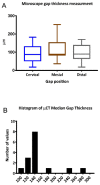3D Printed Temporary Veneer Restoring Autotransplanted Teeth in Children: Design and Concept Validation Ex Vivo
- PMID: 30754648
- PMCID: PMC6388193
- DOI: 10.3390/ijerph16030496
3D Printed Temporary Veneer Restoring Autotransplanted Teeth in Children: Design and Concept Validation Ex Vivo
Abstract
(1) Background: Three-dimensional printing is progressing rapidly and is applied in many fields of dentistry. Tooth autotransplantation offers a viable biological approach to tooth replacement in children and adolescents. Restoring or reshaping the transplanted tooth to the anterior maxilla should be done as soon as possible for psychological and aesthetic reasons. However, to avoid interfering with the natural healing process, reshaping of transplanted teeth is usually delayed three to four months after transplantation. This delay creates a need for simple indirect temporary aesthetic restoration for autotransplanted teeth. The aim of this study was to develop and validate a digital solution for temporary restoration of autotransplanted teeth using 3D printing. (2) Methods: Four dry human skulls and four dry human mandibles were scanned using cone beam computed tomography to create 3D models for 15 premolars. Digital impression of the maxillary arch of one of the skulls was captured by intra oral scanner. The digital work flow for the design and fabrication of temporary veneers is presented. The seating and adaptation of the 3D printed veneers were evaluated using stereomicroscopy and micro-computed tomography. (3) Results: Evaluation of the veneer seating using stereomicroscopy showed that the mean marginal gap at all of the sides was below the cut-off value of 200 µm. The overall mean marginal gap was 99.9 ± 50.7 µm (median: 87.8 (IQR 64.2⁻133 µm)). The internal adaptation evaluation using micro-computed tomography showed an average median gap thickness of 152.5 ± 47.7 (IQR 129⁻149.3 µm). (4) Conclusions: The present concept of using temporary veneers that are designed and fabricated with CAD/CAM (computer-aided design/computer-aided manufacturing) technology using a DLP (digital light processing) printer may present a viable treatment option for restoration of autotransplanted teeth.
Keywords: 3D printing; CAD/CAM; CBCT; DLP; tooth autotransplantation.
Conflict of interest statement
The authors declare no conflicts of interest.
Figures



Similar articles
-
Three-dimensional evaluation of marginal and internal fit of 3D-printed interim restorations fabricated on different finish line designs.J Prosthodont Res. 2018 Apr;62(2):218-226. doi: 10.1016/j.jpor.2017.09.002. Epub 2017 Oct 12. J Prosthodont Res. 2018. PMID: 29032176
-
Accuracy of CAD-CAM Surgically Guided Tooth Autotransplantation Using Guided Templates and Custom-designed Osteotomes in Human Cadaver Mandibles.J Endod. 2023 Aug;49(8):1035-1043. doi: 10.1016/j.joen.2023.06.008. Epub 2023 Jun 20. J Endod. 2023. PMID: 37348814
-
Evaluation of the accuracy of cone beam computed tomography (CBCT) generated tooth replicas with application in autotransplantation.J Dent. 2022 Feb;117:103908. doi: 10.1016/j.jdent.2021.103908. Epub 2021 Nov 29. J Dent. 2022. PMID: 34856326
-
3D printing in dentistry.Br Dent J. 2015 Dec;219(11):521-9. doi: 10.1038/sj.bdj.2015.914. Br Dent J. 2015. PMID: 26657435 Review.
-
Accuracy of 3D Printed Models Created by Two Technologies of Printers with Different Designs of Model Base.J Prosthodont. 2020 Feb;29(2):124-128. doi: 10.1111/jopr.13107. Epub 2019 Sep 9. J Prosthodont. 2020. PMID: 31498957 Review.
Cited by
-
Evaluation of the marginal adaptation and debonding strength of two types of CAD-CAM implant-supported cement-retained crowns.BMC Oral Health. 2023 Dec 5;23(1):967. doi: 10.1186/s12903-023-03711-7. BMC Oral Health. 2023. PMID: 38053146 Free PMC article.
-
What Are the Complications, Success and Survival Rates for Autotransplanted Teeth? An Overview of Systematic Reviews and Metanalyses.Healthcare (Basel). 2022 May 1;10(5):835. doi: 10.3390/healthcare10050835. Healthcare (Basel). 2022. PMID: 35627972 Free PMC article. Review.
-
Evaluation of the Wound Healing Potential of Cynara humilis Extracts in the Treatment of Skin Burns.Evid Based Complement Alternat Med. 2023 Apr 18;2023:5855948. doi: 10.1155/2023/5855948. eCollection 2023. Evid Based Complement Alternat Med. 2023. PMID: 37114146 Free PMC article.
References
-
- Duret F., Preston J.D. CAD/CAM imaging in dentistry. Curr. Opin. Dent. 1991;1:150–154. - PubMed
-
- Vercruyssen M., Coucke W., Naert I., Jacobs R., Teughels W., Quirynen M. Depth and lateral deviations in guided implant surgery: An RCT comparing guided surgery with mental navigation or the use of a pilot-drill template. Clin. Oral. Implants Res. 2015;26:1315–1320. doi: 10.1111/clr.12460. - DOI - PubMed
Publication types
MeSH terms
LinkOut - more resources
Full Text Sources
Other Literature Sources
Miscellaneous

